tire pressure MERCEDES-BENZ METRIS 2019 MY19 Operator’s Manual
[x] Cancel search | Manufacturer: MERCEDES-BENZ, Model Year: 2019, Model line: METRIS, Model: MERCEDES-BENZ METRIS 2019Pages: 318, PDF Size: 5.07 MB
Page 5 of 318
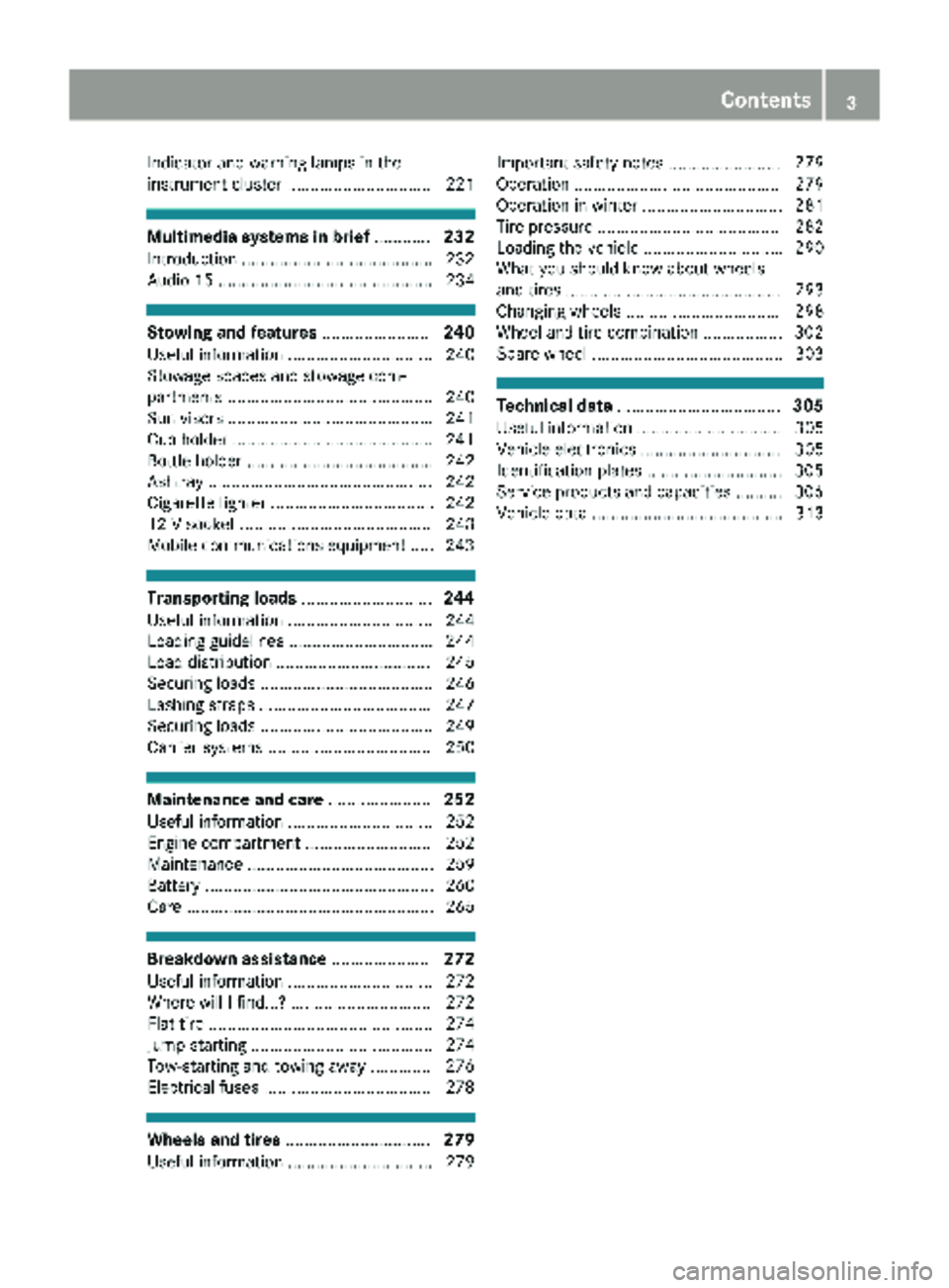
Indicator and warning lamps in the
instrument cluster ............................... 221
Multimedia systems in brief............232
Introduction .........................................2 32
Audio 15 .............................................. 234
Stowing and features .......................240
Useful information ............................... 240
Stowage spaces and stowage com-
partments ............................................ 240
Sun visors ............................................ 241
Cup holder ...........................................2 41
Bottle holder ........................................ 242
Ashtray ................................................ 242
Cigarette lighter ................................... 242
12 V socket ......................................... 243
Mobile communications equipment ..... 243
Transporting loads ............................244
Useful information ............................... 244
Loading guidelines ............................... 244
Load distribution ................................. 245
Securing loads ..................................... 246
Lashing straps ..................................... 247
Securing loads ..................................... 249
Carrier systems ................................... 250
Maintenance and care ......................252
Useful information ............................... 252
Engine compartment ........................... 252
Maintenance ........................................ 259
Battery ................................................. 260
Care ..................................................... 265
Breakdown assistance .....................272
Useful information ............................... 272
Where will I find...? .............................. 272
Flat tire ................................................ 274
Jump-starting ....................................... 274
Tow-starting and towing away ............. 276
Electrical fuses ....................................2 78
Wheels and tires............................... 279
Useful information ............................... 279 Important safety notes ........................ 279
Operation ............................................ 279
Operation in winter .............................. 281
Tire pressure ....................................... 282
Loading the vehicle .............................. 290
What you should know about wheels
and tires .............................................. 293
Changing wheels ................................. 298
Wheel and tire combination ................. 302
Spare wheel ......................................... 303
Technical data
................................... 305
Useful information ............................... 305
Vehicle electronics .............................. 305
Identification plates .............................3 05
Service products and capacities .......... 306
Vehicle data ......................................... 313
Contents3
Page 6 of 318
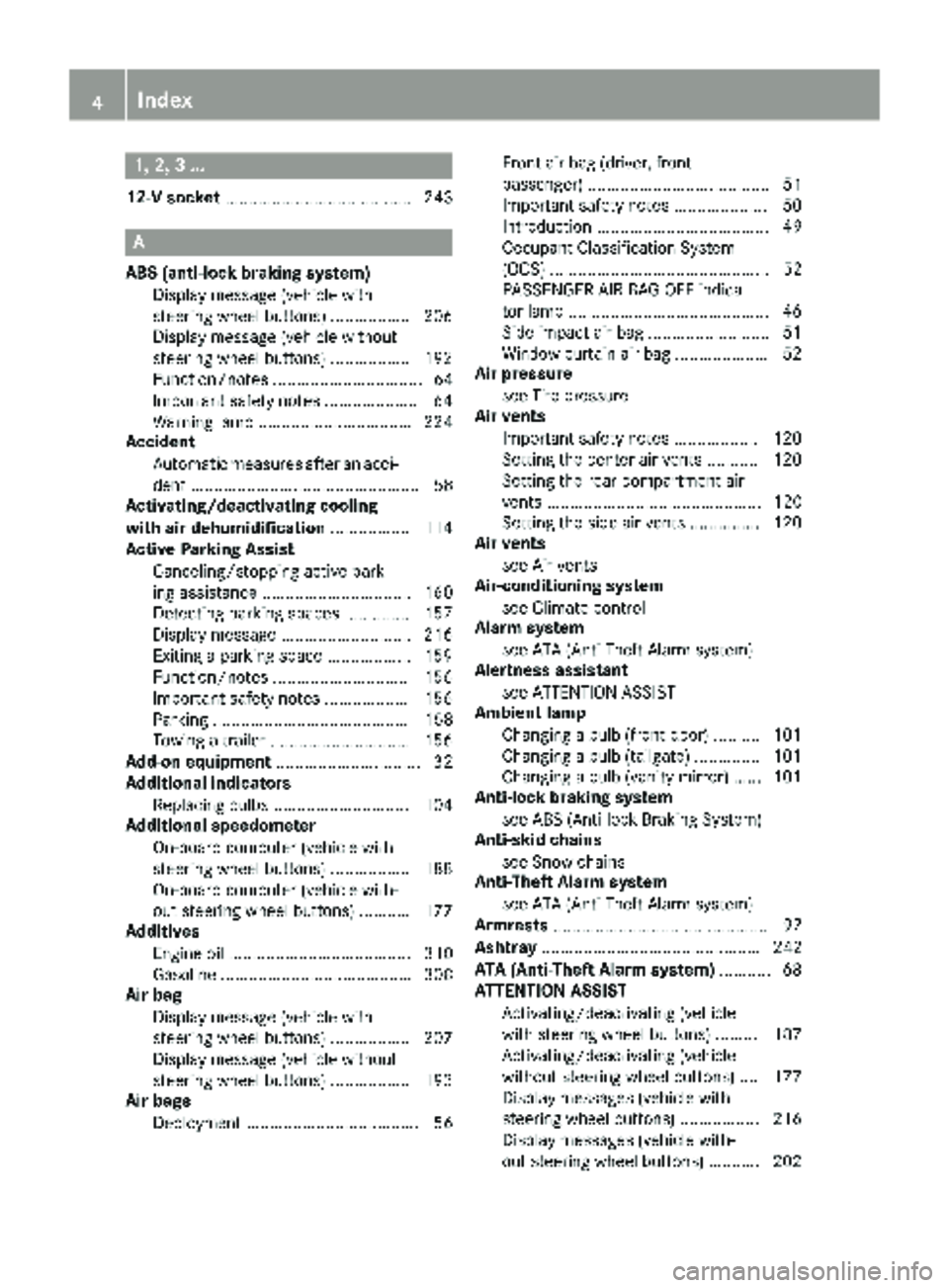
1, 2, 3 ...
12-V socket........................................ 243
A
ABS (anti-lock braking system)
Display message (vehicle with
steering wheel buttons) ................ .206
Display message (vehicle without
steering wheel buttons) ................. 192
Function/notes ................................ 64
Important safety notes .................... 64
Warning lamp ................................. 224
Accident
Automatic measures after an acci-
dent ................................................. 58
Activating/deactivating cooling
with air dehumidification ................. 114
Active Parking Assist
Canceling/stopping active park-
ing assistance ................................ 160
Detecting parking spaces .............. 157
Display message ............................ 216
Exiting a parking space .................. 159
Function/notes .............................1 56
Important safety notes .................. 156
Parking .......................................... 158
Towing a trailer .............................. 156
Add-on equipment ............................... 32
Additional indicators
Replacing bulbs .............................1 04
Additional speedometer
On-board computer (vehicle with
steering wheel buttons) ................. 188
On-board computer (vehicle with-
out steering wheel buttons) ........... 177
Additives
Engine oil ....................................... 310
Gasoline ......................................... 308
Air bag
Display message (vehicle with
steering wheel buttons) ................. 207
Display message (vehicle without
steering wheel buttons) ................. 193
Air bags
Deployment ..................................... 56 Front air bag (driver, front
passenger) ....................................... 51
Important safety notes .................... 50
Introduction ..................................... 49
Occupant Classification System
(OCS) ............................................... 52
PASSENGER AIR BAG OFF indica-
tor lamp ...........................................4
6
Side impact air bag .......................... 51
W
indow curtain air bag .................... 52
Air pressure
see Tire pressure
Air vents
Important safety notes .................. 120
Setting the center air vents ........... 120
Setting the rear-compartment air
vents .............................................. 120
Setting the side air vents ............... 120
Air vents
see Air vents
Air-conditioning system
see Climate control
Alarm system
see ATA (Anti-Theft Alarm system)
Alertness assistant
see ATTENTION ASSIST
Ambient lamp
Changing a bulb (front door) .......... 101
Changing a bulb (tailgate) .............. 101
Changing a bulb (vanity mirror) ...... 101
Anti-lock braking system
see ABS (Anti-lock Braking System)
Anti-skid chains
see Snow chains
Anti-Theft Alarm system
see ATA (Anti-Theft Alarm system)
Armrests .............................................. 92
Ashtray ............................................... 242
ATA (Anti-Theft Alarm system) ........... 68
ATTENTION ASSIST
Activating/deactivating (vehicle
with steering wheel buttons) ......... 187
Activating/deactivating (vehicle
without steering wheel buttons) .... 177
Display messages (vehicle with
steering wheel buttons) ................. 216
Display messages (vehicle with-
out steering wheel buttons) ........... 202
4Index
Page 24 of 318
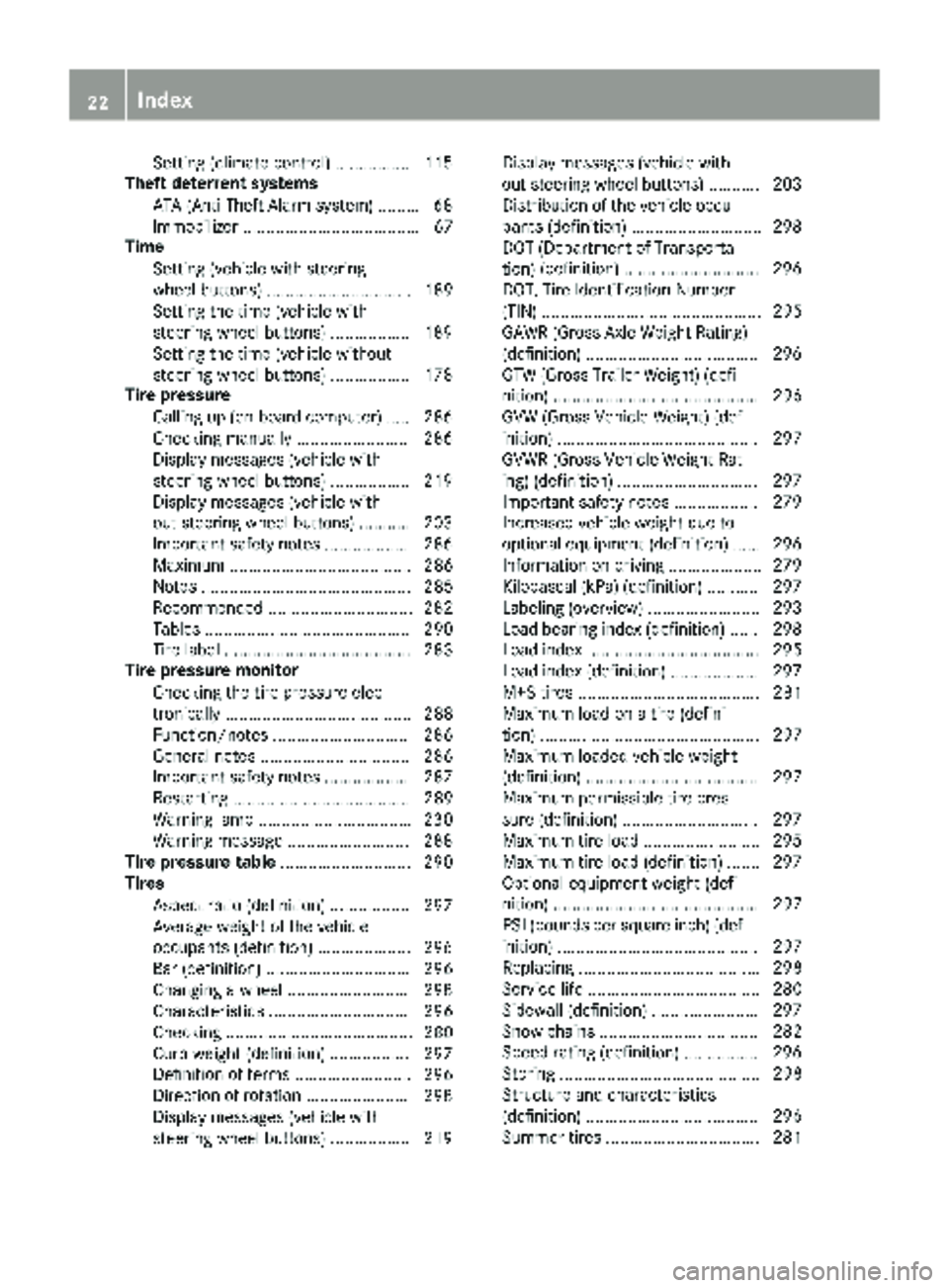
Setting (climate control) ................ 115
Theft deterrent systems
ATA (Anti-Theft Alarm system) ......... 68
Immobilizer ...................................... 67
Time
Setting (vehicle with steering
wheel buttons) ............................... 189
Setting the time (vehicle with
steering wheel buttons) ................. 189
Setting the time (vehicle without
steering wheel buttons) ................. 178
Tire pressure
Calling up (on-board computer) ..... 286
Checking manually ........................ 286
Display messages (vehicle with
steering wheel buttons) ................. 219
Display messages (vehicle with-
out steering wheel buttons) ........... 203
Important safety notes .................. 286
Maximum ....................................... 286
Notes ............................................. 285
Recommended ............................... 282
Tables ............................................ 290
Tire label ........................................ 283
Tire pressure monitor
Checking the tire pressure elec-
tronically ........................................ 288
Function/notes ............................. 286
General notes ................................ 286
Important safety notes .................. 287
Restarting ...................................... 289
Warning lamp ................................. 230
Warning message .......................... 288
Tire pressure table ............................ 290
Tires
Aspect ratio (definition) ................. 297
Average weight of the vehicle
occupants (definition) .................... 296
Bar (definition) ............................... 296
Changing a wheel .......................... 298
Characteristics .............................. 296
Checking ........................................ 280
Curb weight (definition) ................. 297
Definition of terms ......................... 296
Direction of rotation ...................... 298
Display messages (vehicle with
steering wheel buttons) ................. 219 Display messages (vehicle with-
out steering wheel buttons) ........... 203
Distribution of the vehicle occu-
pants (definition) ............................ 298
DOT (Department of Transporta-
tion)
(de
finition) ............................. 296
DOT, Tire Identification Number
(TIN) ............................................... 295
GAWR (Gross Axle Weight Rating)
(definition) ..................................... 296
GTW (Gross Trailer Weight) (defi-
nition) ............................................ 296
GVW (Gross Vehicle Weight) (def-
inition) ........................................... 297
GVWR (Gross Vehicle Weight Rat-
ing) (definition) .............................. 297
Important safety notes .................. 279
Increased vehicle weight due to
optional equipment (definition) ...... 296
Information on driving .................... 279
Kilopascal (kPa) (definition) ........... 297
Labeling (overview) ........................ 293
Load bearing index (definition) ...... 298
Load index ..................................... 295
Load index (definition) ................... 297
M+S tires ....................................... 281
Maximum load on a tire (defini-
tion) ............................................... 297
Maximum loaded vehicle weight
(definition) ..................................... 297
Maximum permissible tire pres-
sure (definition) ............................. 297
Maximum tire load ......................... 295
Maximum tire load (definition) ....... 297
Optional equipment weight (defi-
nition) ............................................ 297
PSI (pounds per square inch) (def-
inition) ........................................... 297
Replacing ....................................... 298
Service life ..................................... 280
Sidewall (definition) ....................... 297
Snow chains .................................. 282
Speed rating (definition) ................ 296
Storing ........................................... 298
Structure and characteristics
(definition) ..................................... 296
Summer tires ................................. 281
22Index
Page 25 of 318
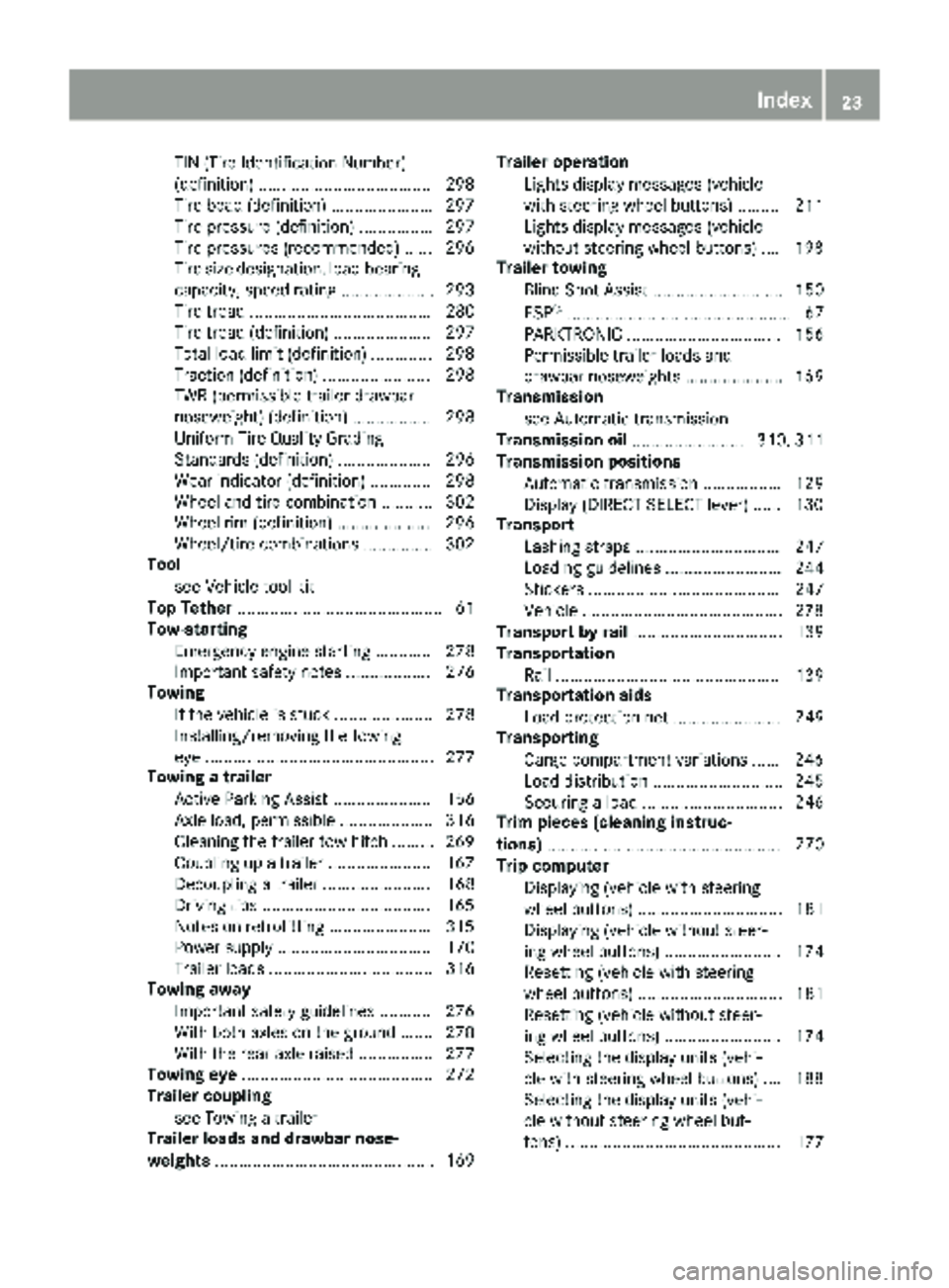
TIN (Tire Identification Number)
(definition) .....................................298
Tire bead (definition) ......................2 97
Tire pressure (definition) ................ 297
Tire pressures (recommended) ...... 296
Tire size designation, load-bearing
capacity, speed rating .................... 293
Tire tread ....................................... 280
Tire tread (definition) ..................... 297
Total load limit (definition) ............. 298
Traction (definition) ....................... 298
TWR (permissible trailer drawbar
noseweight) (definition) ................. 298
Uniform Tire Quality Grading
Standards (definition) .................... 296
Wear indicator (definition) ............. 298
Wheel and tire combination ........... 302
Wheel rim (definition) .................... 296
Wheel/tire combinations ...............3 02
Tool
see Vehicle tool kit
Top Tether ............................................ 61
Tow-starting
Emergency engine starting ............ 278
Important safety notes .................. 276
Towing
If the vehicle is stuck ..................... 278
Installing/removing the towing
eye ................................................. 277
Towing a trailer
Active Parking Assist ..................... 156
Axle load, permissible .................... 316
Cleaning the trailer tow hitch ......... 269
Coupling up a trailer ......................1 67
Decoupling a trailer ....................... 168
Driving tips ....................................1 65
Notes on retrofitting ......................3 15
Power supply ................................. 170
Trailer loads ................................... 316
Towing away
Important safety guidelines ........... 276
With both axles on the ground ....... 278
With the rear axle raised ................ 277
Towing eye ......................................... 272
Trailer coupling
see Towing a trailer
Trailer loads and drawbar nose-
weights ............................................... 169 Trailer operation
Lights display messages (vehicle
with steering wheel buttons) ......... 211
Lights display messages (vehicle
without steering wheel buttons) .... 198
Trailer towing
Blind Spot Assist ............................ 150
ESP
®................................................ 67
PARKTRONIC ................................. 156
Permissible trailer loads and
drawbar noseweights ..................... 169
Transmission
see Automatic transmission
Transmission oil ........................ 310, 311
Transmission positions
Automatic transmission ................. 129
Display (DIRECT SELECT lever) ...... 130
Transport
Lashing straps ............................... 247
Loading guidelines ......................... 244
Stickers ......................................... 247
Vehicle ...........................................2 78
Transport by rail ................................ 139
Transportation
Rail ................................................ 139
Transportation aids
Load protection net ....................... 249
Transporting
Cargo compartment variations ...... 246
Load distribution ............................ 245
Securing a load .............................. 246
Trim pieces (cleaning instruc-
tions) .................................................. 270
Trip computer
Displaying (vehicle with steering
wheel buttons) ............................... 181
Displaying (vehicle without steer-
ing wheel buttons) ......................... 174
Resetting (vehicle with steering
wheel buttons) ............................... 181
Resetting (vehicle without steer-
ing wheel buttons) ......................... 174
Selecting the display units (vehi-
cle with steering wheel buttons) .... 188
Selecting the display units (vehi-
cle without steering wheel but-
tons) .............................................. 177
Index23
Page 27 of 318
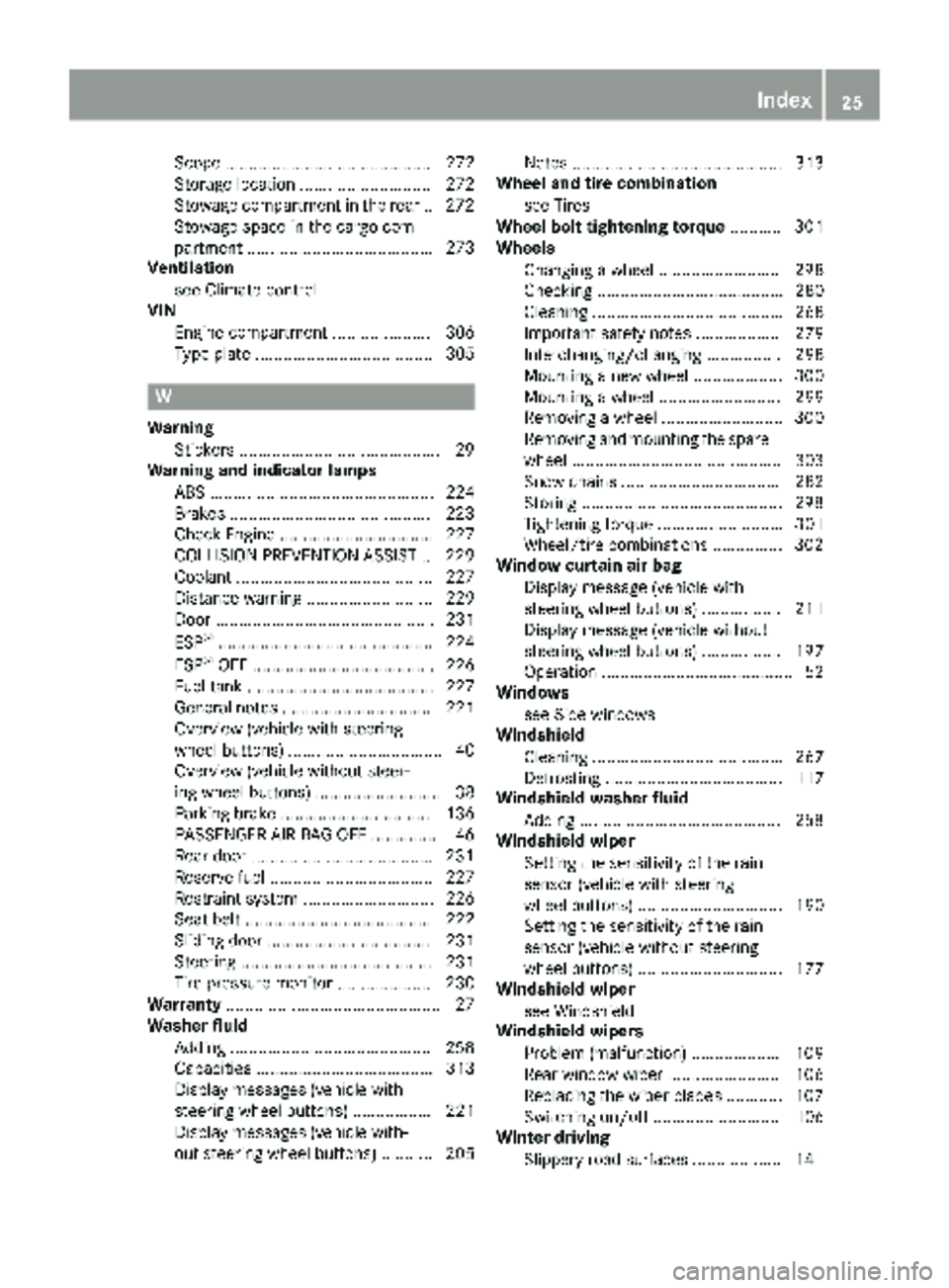
Scope ............................................ 272
Storage location ............................ 272
Stowage compartment in the rear..272
Stowage space in the cargo com-
partment ........................................ 273
Ventilation
see Climate control
VIN
Engine compartment ..................... 306
Type plate ...................................... 305
W
WarningStickers ...........................................2 9
Warning and indicator lamps
ABS ................................................ 224
Brakes ...........................................2 23
Check Engine ................................. 227
COLLISION PREVENTION ASSIST .. 229
Coolant .......................................... 227
Distance warning ........................... 229
Door ............................................... 231
ESP
®.............................................. 224
ESP®OFF ....................................... 226
Fuel tank ........................................ 227
General notes ................................ 221
Overview (vehicle with steering
wheel buttons) ................................. 40
Overview (vehicle without steer-
ing wheel buttons) ........................... 38
Parking brake ................................ 136
PASSENGER AIR BAG OFF ...............4 6
Rear doo r...................................... .231
Reserve fuel ................................... 227
Restraint system ............................ 226
Seat belt ........................................ 222
Sliding door ................................... 231
Steering ......................................... 231
Tire pressure monitor .................... 230
Warranty .............................................. 27
Washer fluid
Adding ...........................................2 58
Capacities ...................................... 313
Display messages (vehicle with
steering wheel buttons) ................. 221
Display messages (vehicle with-
out steering wheel buttons) ........... 205 Notes ............................................. 313
Wheel and tire combination
see Tires
Wheel bolt tightening torque ........... 301
Wheels
Changing a wheel .......................... 298
Checking ........................................ 280
Cleaning ......................................... 268
Important safety notes .................. 279
Interchanging/changing ................ 298
Mounting a new wheel ................... 300
Mounting a whe el .......................... 299
R
emoving a wheel .......................... 300
Removing and mounting the spare wheel ............................................. 303
Snow chains .................................. 282
Storing ...........................................2 98
Tightening torque ........................... 301
Wheel/tire combinations ...............3 02
Window curtain air bag
Display message (vehicle with
steering wheel buttons) ................. 211
Display message (vehicle without
steering wheel buttons) ................. 197
Operation ......................................... 52
Windows
see Side windows
Windshield
Cleaning ......................................... 267
Defrosting ...................................... 117
Windshield washer fluid
Adding ...........................................2 58
Windshield wiper
Setting the sensitivity of the rain
sensor (vehicle with steering
wheel buttons) ............................... 190
Setting the sensitivity of the rain
sensor (vehicle without steering
wheel buttons) ............................... 177
Windshield wiper
see Windshield
Windshield wipers
Problem (malfunction) ................... 109
Rear window wiper ........................ 106
Replacing the wiper blades ............ 107
Switching on/off ........................... 106
Winter driving
Slippery road surfaces ................... 141
Index25
Page 32 of 318
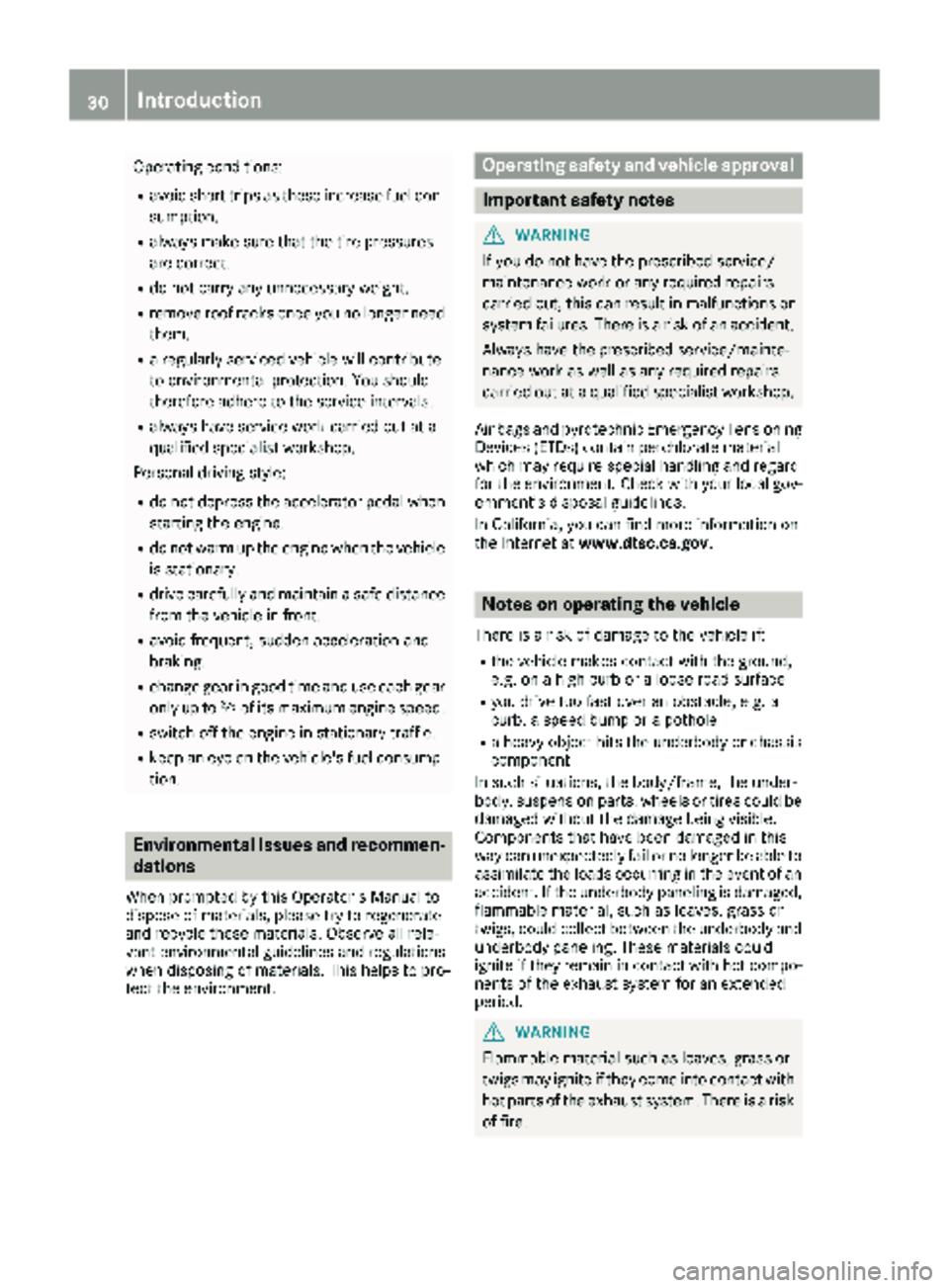
Operating conditions:
Ravoid short trips as these increase fuel con-
sumption.
Ralways make sure that the tire pressures
are correct.
Rdo not carry any unnecessary weight.
Rremove roof racks once you no longer need
them.
Ra regularly serviced vehicle will contribute
to environmental protection. You should
therefore adhere to the service intervals.
Ralways have service work carried out at a
qualified specialist workshop.
Personal driving style:
Rdo not depress the accelerator pedal when
starting the engine.
Rdo not warm up the engine when the vehicle
is stationary.
Rdrive carefully and maintain a safe distance
from the vehicle in front.
Ravoid frequent, sudden acceleration and
braking.
Rchange gear in good time and use each gear
only up to Ôof its maximum engine speed.
Rswitch off the engine in stationary traffic.
Rkeep an eye on the vehicle's fuel consump-
tion.
Environmental issues and recommen-
dations
When prompted by this Operator's Manual to
dispose of materials, please try to regenerate
and recycle these materials. Observe all rele-
vant environmental guidelines and regulations
when disposing of materials. This helps to pro-
tect the environment.
Operating safety and vehicle approval
Important safety notes
GWARNING
If you do not have the prescribed service/
maintenance work or any required repairs
carried out, this can result in malfunctions or system failures. There is a risk of an accident.
Always have the prescribed service/mainte-
nance work as well as any required repairs
carried out at a qualified specialist workshop.
Air bags and pyrotechnic Emergency Tensioning
Devices (ETDs) contain perchlorate material
which may require special handling and regard
for the environment. Check with your local gov- ernment’s disposal guidelines.
In California, you can find more information on
the Internet at www.dtsc.ca.gov.
Notes on operating the vehicle
There is a risk of damage to the vehicle if:
Rthe vehicle makes contact with the ground,
e.g. on a high curb or a loose road surface
Ryou drive too fast over an obstacle, e.g. a
curb, a speed bump or a pothole
Ra heavy object hits the underbody or chassis
component
In such situations, the body/frame, the under-
body, suspension parts, wheels or tires could be
damaged without the damage being visible.
Components that have been damaged in this
way can unexpectedly fail or no longer be able to assimilate the loads occurring in the event of an
accident. If the underbody paneling is damaged,
flammable material, such as leaves, grass or
twigs, could collect between the underbody and
underbody paneling. These materials could
ignite if they remain in contact with hot compo-
nents of the exhaust system for an extended
period.
GWARNING
Flammable material such as leaves, grass or
twigs may ignite if they come into contact with
hot parts of the exhaust system. There is a risk of fire.
30Introduction
Page 36 of 318
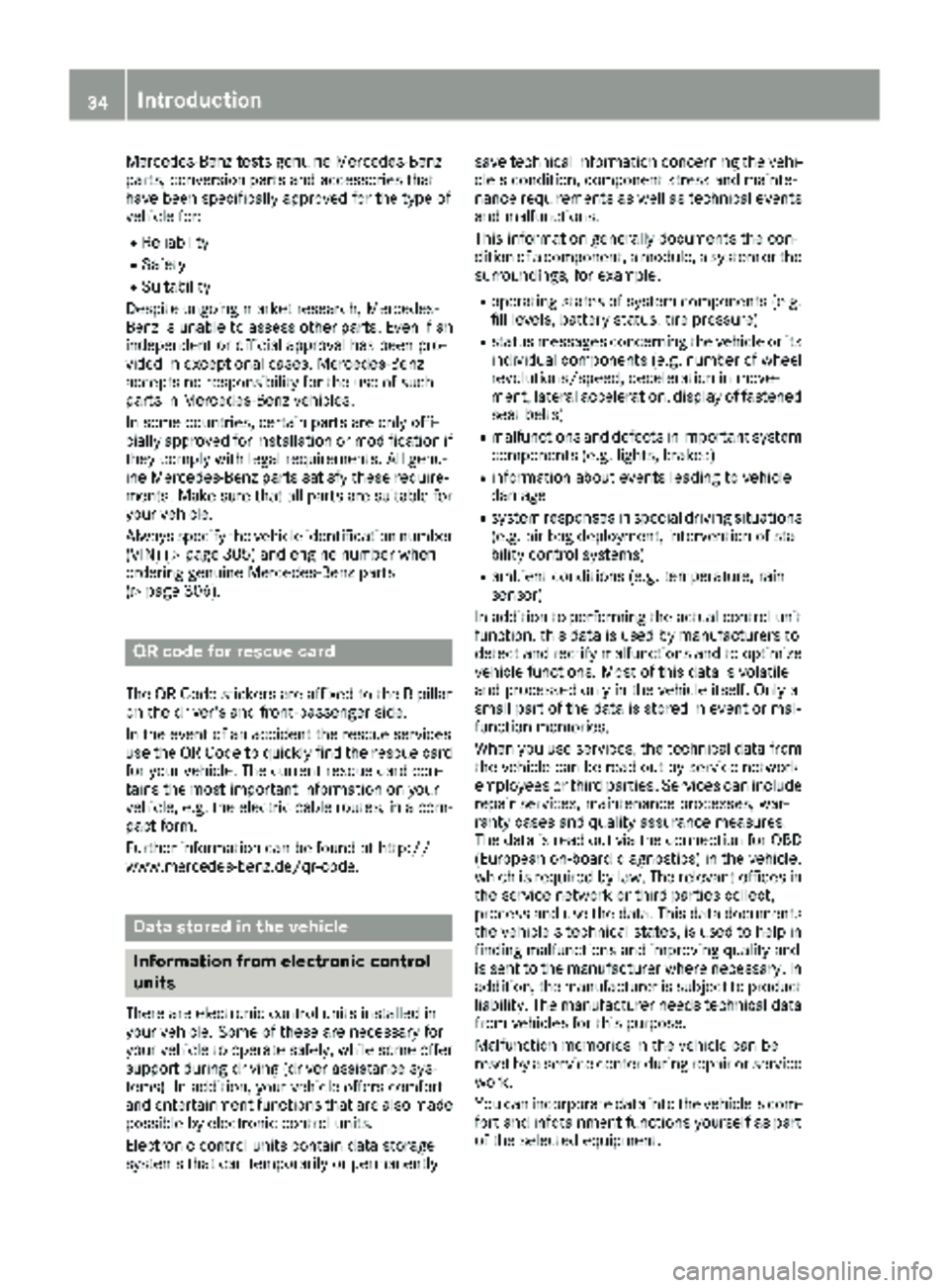
Mercedes-Benz tests genuine Mercedes-Benz
parts, conversion parts and accessories that
have been specifically approved for the type of
vehicle for:
RReliability
RSafety
RSuitability
Despite ongoing market research, Mercedes-
Benz is unable to assess other parts. Even if an
independent or official approval has been pro-
vided in exceptional cases, Mercedes-Benz
accepts no responsibility for the use of such
parts in Mercedes-Benz vehicles.
In some countries, certain parts are only offi-
cially approved for installation or modification if
they comply with legal requirements. All genu-
ine Mercedes-Benz parts satisfy these require-
ments. Make sure that all parts are suitable for
your vehicle.
Always specify the vehicle identification number
(VIN) (
Ypage 305) and engine number when
ordering genuine Mercedes-Benz parts
(
Ypage 306).
QR code for rescue card
The QR Code stickers are affixed to the B-pillar
on the driver's and front-passenger side.
In the event of an accident the rescue services
use the QR Code to quickly find the rescue card for your vehicle. The current rescue card con-
tains the most important information on your
vehicle, e.g. the electric cable routes, in a com-
pact form.
Further information can be found at http://
www.mercedes-benz.de/qr-code.
Data stored in the vehicle
Information from electronic control
units
There are electronic control units installed in
your vehicle. Some of these are necessary for
your vehicle to operate safely, while some offer
support during driving (driver assistance sys-
tems). In addition, your vehicle offers comfort
and entertainment functions that are also made
possible by electronic control units.
Electronic control units contain data storage
systems that can temporarily or permanently save technical information concerning the vehi-
cle's condition, component stress and mainte-
nance requirements as well as technical events
and malfunctions.
This information generally documents the con-
dition of a component, a module, a system or the surroundings, for example:
Roperating states of system components (e.g.
fill levels, battery status, tire pressure)
Rstatus messages concerning the vehicle or its
individual components (e.g. number of wheel
revolutions/speed, deceleration in move-
ment, lateral acceleration, display of fastened
seat belts)
Rmalfunctions and defects in important system
components (e.g. lights, brakes)
Rinformation about events leading to vehicle
damage
Rsystem responses in special driving situations
(e.g. air bag deployment, intervention of sta-
bility control systems)
Rambient conditions (e.g. temperature, rain
sensor)
In addition to performing the actual control unit function, this data is used by manufacturers to
detect and rectify malfunctions and to optimize
vehicle functions. Most of this data is volatile
and processed only in the vehicle itself. Only a
small part of the data is stored in event or mal-
function memories.
When you use services, the technical data from
the vehicle can be read out by service network
employees or third parties. Services can include
repair services, maintenance processes, war-
ranty cases and quality assurance measures.
The data is read out via the connection for OBD
(European on-board diagnostics) in the vehicle,
which is required by law. The relevant offices in
the service network or third parties collect,
process and use the data. This data documents
the vehicle's technical states, is used to help in
finding malfunctions and improving quality and
is sent to the manufacturer where necessary. Inaddition, the manufacturer is subject to product
liability. The manufacturer needs technical data
from vehicles for this purpose.
Malfunction memories in the vehicle can be
reset by a service center during repair or service
work.
You can incorporate data into the vehicle's com-
fort and infotainment functions y
ourself as part
of the selected equipment.
34Introduction
Page 66 of 318
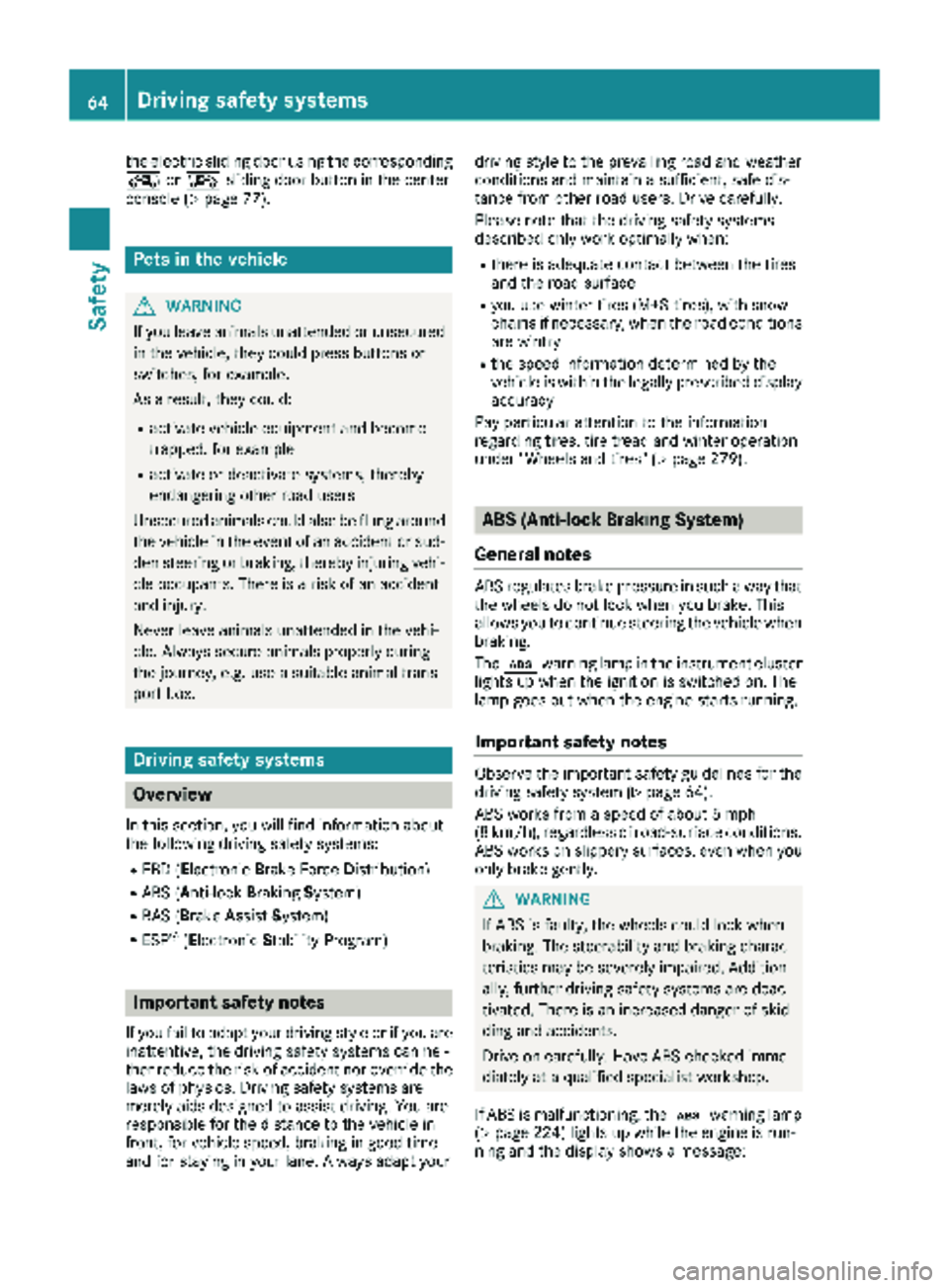
the electric sliding door using the corresponding
ÅorÆ sliding door button in the center
console (
Ypage 77).
Pets in the vehicle
GWARNING
If you leave animals unattended or unsecured
in the vehicle, they could press buttons or
switches, for example.
As a result, they could:
Ractivate vehicle equipment and become
trapped, for example
Ractivate or deactivate systems, thereby
endangering other road users
Unsecured animals could also be flung around
the vehicle in the event of an accident or sud-
den steering or braking, thereby injuring vehi-
cle occupants. There is a risk of an accident
and injury.
Never leave animals unattended in the vehi-
cle. Always secure animals properly during
the journey, e.g. use a suitable animal trans-
port box.
Driving safety systems
Overview
In this section, you will find information about
the following driving safety systems:
REBD ( Electronic Brake Force Distribution)
RABS ( Anti-lock Braking System)
RBAS ( Brake Assist System)
RESP®(E lectronic Stability Program)
Important safety notes
If you fail to adapt your driving style or if you are
inattentive, the driving safety systems can nei-
ther reduce the risk of accident nor override the
laws of physics. Driving safety systems are
merely aids designed to assist driving. You are
responsible for the distance to the vehicle in
front, for vehicle speed, braking in good time
and for staying in your lane. Always adapt your driving style to the prevailing road and weather
conditions and maintain a sufficient, safe dis-
tance from other road users. Drive carefully.
Please note that the driving safety systems
described only work optimally when:
Rthere is adequate contact between the tires
and the road surface
Ryou use winter tires (M+S tires), with snow
chains if necessary, when the road conditions
are wintry
Rthe speed information determined by the
vehicle is within the legally prescribed display
accuracy
Pay particular attention to the information
regarding tires, tire tread and winter operation
under "Wheels and tires" (
Ypage 279).
ABS (Anti-lock Braking System)
General notes
ABS regulates brake pressure in such a way that the wheels do not lock when you brake. This
allows you to continue steering the vehicle when
braking.
The ò warning lamp in the instrument cluster
lights up when the ignition is switched on. The
lamp goes out when the engine starts running.
Important safety notes
Observe the important safety guidelines for the
driving safety system (Ypage 64).
ABS works from a speed of about 5 mph
(8 km/h), regardless of road-surface conditions. ABS works on slippery surfaces, even when you
only brake gently.
GWARNING
If ABS is faulty, the wheels could lock when
braking. The steerability and braking charac-
teristics may be severely impaired. Addition-
ally, further driving safety systems are deac-
tivated. There is an increased danger of skid-
ding and accidents.
Drive on carefully. Have ABS checked imme-
diately at a qualified specialist workshop.
If ABS is malfunctioning, the òwarning lamp
(
Ypage 224) lights up while the engine is run-
ning and the display shows a message:
64Driving safet ysystem s
Safety
Page 137 of 318
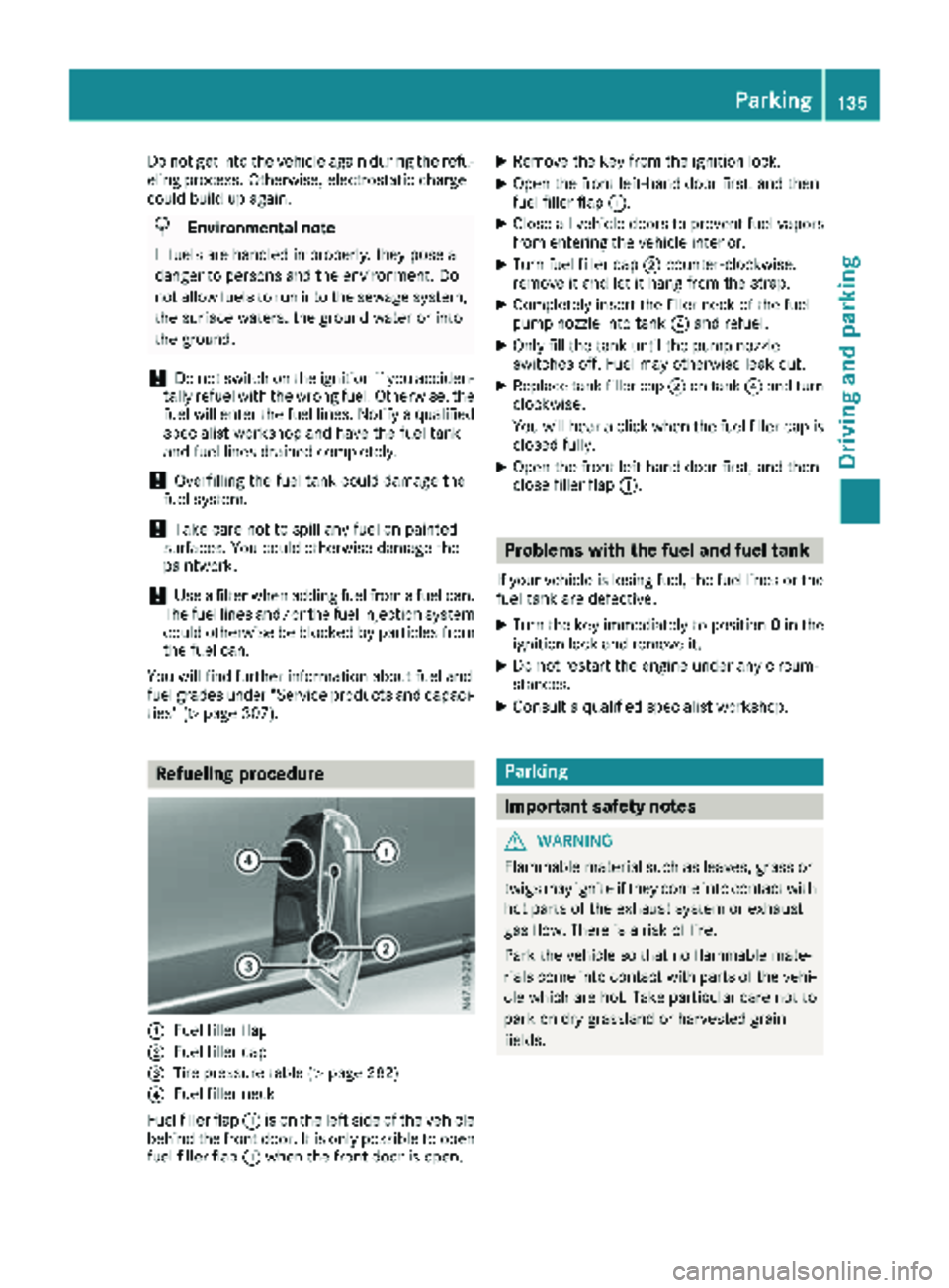
Do not get into the vehicle again during the refu-
eling process. Otherwise, electrostatic charge
could build up again.
HEnvironmental note
If fuels are handled improperly, they pose a
danger to persons and the environment. Do
not allow fuels to run into the sewage system,
the surface waters, the ground water or into
the ground.
!Do not switch on the ignition if you acciden-
tally refuel with the wrong fuel. Otherwise, the
fuel will enter the fuel lines. Notify a qualified
specialist workshop and have the fuel tank
and fuel lines drained completely.
!Overfilling the fuel tank could damage the
fuel system.
!Take care not to spill any fuel on painted
surfaces. You could otherwise damage the
paintwork.
!Use a filter when adding fuel from a fuel can.
The fuel lines and/or the fuel injection system
could otherwise be blocked by particles from
the fuel can.
You will find further information about fuel and
fuel grades under "Service products and capaci-
ties" (
Ypage 307).
Refueling procedure
:Fuel filler flap
;Fuel filler cap
=Tire pressure table (Ypage 282)
?Fuel filler neck
Fuel filler flap :is on the left side of the vehicle
behind the front door. It is only possible to open fuel filler flap :when the front door is open.
XRemove the key from the ignition lock.
XOpen the front left-hand door first, and then
fuel filler flap :.
XClose all vehicle doors to prevent fuel vapors
from entering the vehicle interior.
XTurn fuel filler cap ;counter-clockwise,
remove it and let it hang from the strap.
XCompletely insert the filler neck of the fuel
pump nozzle into tank ?and refuel.
XOnly fill the tank until the pump nozzle
switches off. Fuel may otherwise leak out.
XReplace tank filler cap ;on tank ?and turn
clockwise.
You will hear a click when the fuel filler cap is
closed fully.
XOpen the front left-hand door first, and then
close filler flap :.
Problems with the fuel and fuel tank
If your vehicle is losing fuel, the fuel lines or the
fuel tank are defective.
XTurn the key immediately to position 0in the
ignition lock and remove it.
XDo not restart the engine under any circum-
stances.
XConsult a qualified specialist workshop.
Parking
Important safety notes
GWARNING
Flammable material such as leaves, grass or
twigs may ignite if they come into contact with
hot parts of the exhaust system or exhaust
gas flow. There is a risk of fire.
Park the vehicle so that no flammable mate-
rials come into contact with parts of the vehi-
cle which are hot. Take particular care not to
park on dry grassland or harvested grain
fields.
Parking135
Driving an d parking
Z
Page 140 of 318
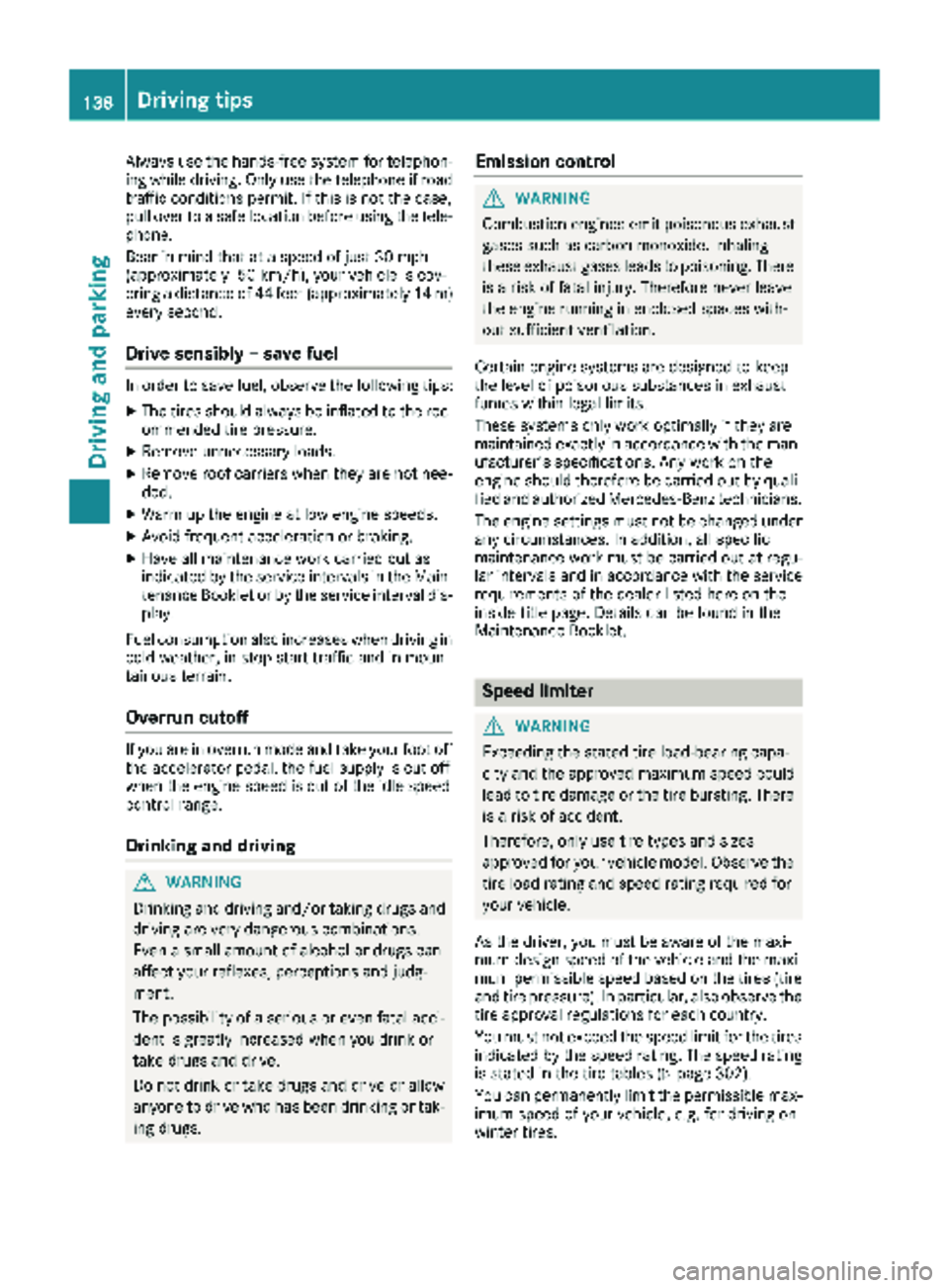
Always use the hands-free system for telephon-
ing while driving. Only use the telephone if road
traffic conditions permit. If this is not the case,
pull over to a safe location before using the tele-
phone.
Bear in mind that at a speed of just 30 mph
(approximately 50 km/h), your vehicle is cov-
ering a distance of 44 fee t(approximately 14 m)
every second.
Drive sensibly – save fuel
In order to save fuel, observe the following tips:
XThe tires should always be inflated to the rec-
ommended tire pressure.
XRemove unnecessary loads.
XRemove roof carriers when they are not nee-
ded.
XWarm up the engine at low engine speeds.
XAvoid frequent acceleration or braking.
XHave all maintenance work carried out as
indicated by the service intervals in the Main-
tenance Booklet or by the service interval dis-
play.
Fuel consumption also increases when driving in cold weather, in stop-start traffic and in moun-
tainous terrain.
Overrun cutoff
If you are in overrun mode and take your foot off
the accelerator pedal, the fuel supply is cut off
when the engine speed is out of the idle speed
control range.
Drinking and driving
GWARNING
Drinking and driving and/or taking drugs and driving are very dangerous combinations.
Even a small amount of alcohol or drugs can
affect your reflexes, perceptions and judg-
ment.
The possibility of a serious or even fatal acci-
dent is greatly increased when you drink or
take drugs and drive.
Do not drink or take drugs and drive or allow
anyone to drive who has been drinking or tak-
ing drugs.
Emission control
GWARNING
Combustion engines emit poisonous exhaust
gases such as carbon monoxide. Inhaling
these exhaust gases leads to poisoning. There
is a risk of fatal injury. Therefore never leave
the engine running in enclosed spaces with-
out sufficient ventilation.
Certain engine systems are designed to keep
the level of poisonous substances in exhaust
fumes within legal limits.
These systems only work optimally if they are
maintained exactly in accordance with the man-
ufacturer's specifications. Any work on the
engine should therefore be carried out by quali-
fied and authorized Mercedes-Benz technicians.
The engine settings must not be changed under
any circumstances. In addition, all specific
maintenance work must be carried out at regu-
lar intervals and in accordance with the service
requirements of the dealer listed here on the
inside title page. Details can be found in the
Maintenance Booklet.
Speed limiter
GWARNING
Exceeding the stated tire load-bearing capa-
city and the approved maximum speed could
lead to tire damage or the tire bursting. There is a risk of accident.
Therefore, only use tire types and sizes
approved for your vehicle model. Observe the
tire load rating and speed rating required for
your vehicle.
As the driver, you must be aware of the maxi-
mum design speed of the vehicle and the maxi- mum permissible speed based on the tires (tire
and tire pressure). In particular, also observe the tire approval regulations for each country.
You must not exceed the speed limit for the tires
indicated by the speed rating. The speed rating
is stated in the tire tables (
Ypage 302).
You can permanently limit the permissible max-
imum speed of your vehicle, e.g. for driving on
winter tires.
138Driving tips
Driving and parking